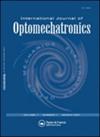用改进奥托光学结构精确测量金属表面介电层厚度
IF 2.3
3区 工程技术
Q1 ENGINEERING, ELECTRICAL & ELECTRONIC
引用次数: 8
摘要
提出了一种改进的基于Otto光学结构(O-configuration)的金属介质涂层厚度测量方法。这种方法使我们能够估计涂层厚度,通常范围从几十纳米到超过一微米,精度小于几纳米。测量介质涂层厚度的常用方法是利用抑制全内反射。为了测量几十纳米的厚度,可以利用p偏振光产生的表面等离子体共振(SPR)现象。对于大于100纳米的厚度,可以采用p或s偏振光产生的金属包层泄漏波导(MCLW)模式,而无需对光学装置进行重大更改。数值和实验验证了改进的o型结构对金属中厚介质涂层精确测量的有效性。本文章由计算机程序翻译,如有差异,请以英文原文为准。
Precise Measurement of the Thickness of a Dielectric Layer on a Metal Surface by Use of a Modified Otto Optical Configuration
We propose a modified method for thickness measurement of a dielectric coating layer on metal based on Otto optical configuration (O-configuration). This method enables us to estimate the coating thickness that typically ranges from several tens of nanometers to more than one micrometer with precision less than a few nanometers. The common method to measure the thickness of dielectric coating layer is to utilize the frustrated total-internal reflection. In order to measure the thickness of several tens of nanometers, one can apply the surface-plasmon-resonance (SPR) phenomenon generated by the p-polarized light. For thickness larger than one hundred nanometers, a metal-clad leaky-waveguide (MCLW) mode generated by the p- or the s-polarized light can be employed without significant changes to the optical setup. The numerical and experimental verifications of the modified O-configuration reveals its effectiveness for precise measurement of moderately-thick dielectric coating layer on the metal.
求助全文
通过发布文献求助,成功后即可免费获取论文全文。
去求助
来源期刊

International Journal of Optomechatronics
工程技术-工程:电子与电气
CiteScore
9.30
自引率
0.00%
发文量
3
审稿时长
3 months
期刊介绍:
International Journal of Optomechatronics publishes the latest results of multidisciplinary research at the crossroads between optics, mechanics, fluidics and electronics.
Topics you can submit include, but are not limited to:
-Adaptive optics-
Optomechanics-
Machine vision, tracking and control-
Image-based micro-/nano- manipulation-
Control engineering for optomechatronics-
Optical metrology-
Optical sensors and light-based actuators-
Optomechatronics for astronomy and space applications-
Optical-based inspection and fault diagnosis-
Micro-/nano- optomechanical systems (MOEMS)-
Optofluidics-
Optical assembly and packaging-
Optical and vision-based manufacturing, processes, monitoring, and control-
Optomechatronics systems in bio- and medical technologies (such as optical coherence tomography (OCT) systems or endoscopes and optical based medical instruments)
 求助内容:
求助内容: 应助结果提醒方式:
应助结果提醒方式:


